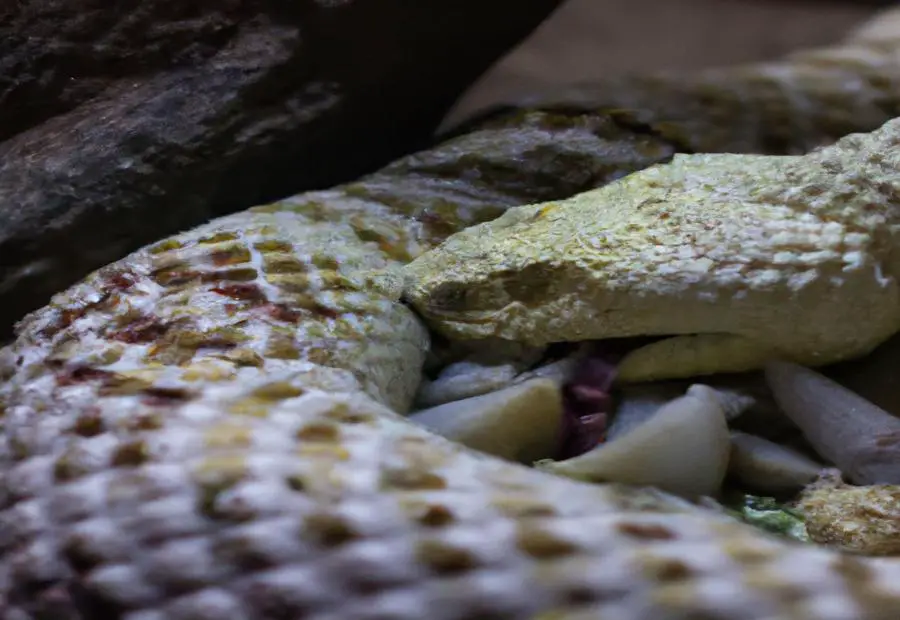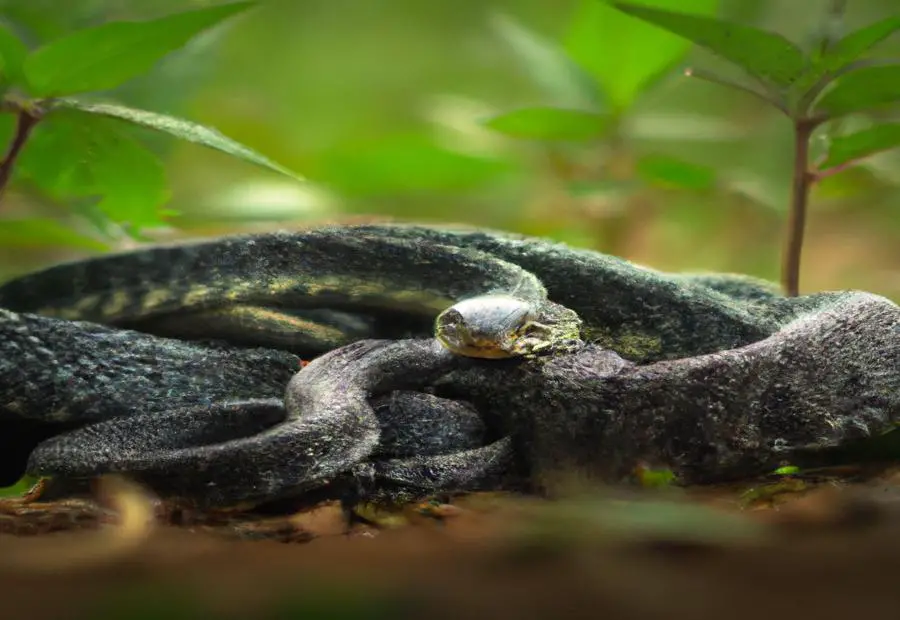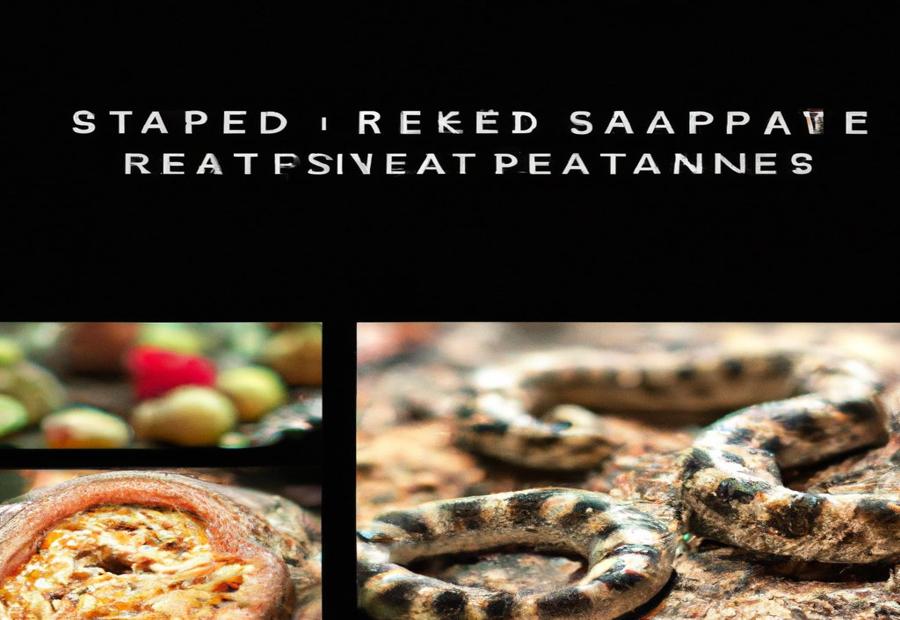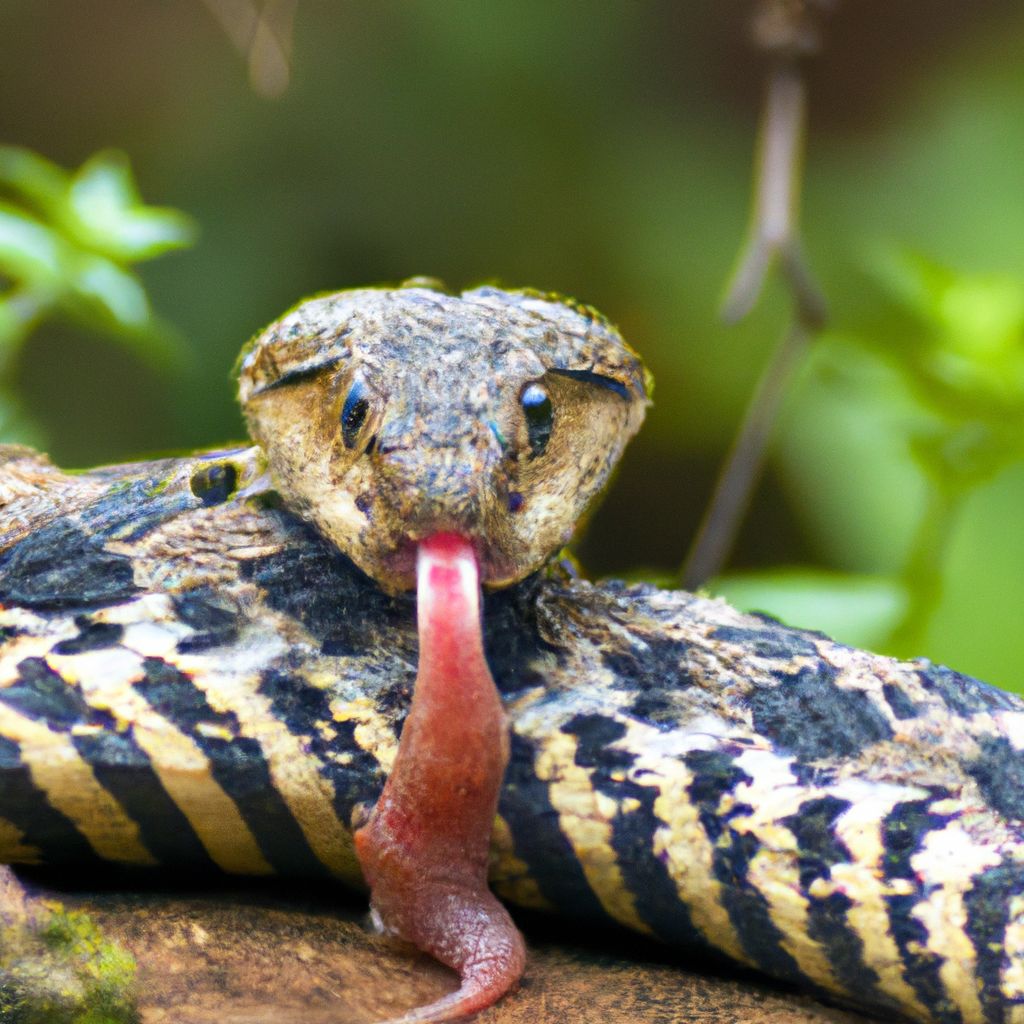Rattlesnakes, a group of venomous snakes known for their distinctive rattles, are fascinating creatures with unique dietary habits. Understanding what rattlesnakes eat and how their diet compares to other snake species can shed light on their behavior and physiology. In this article, we will delve into the diets of rattlesnakes and other snake species, exploring their hunting methods and preferred prey. We will compare the diets of rattlesnakes to those of other snake species, examining whether rattlesnakes are exclusive carnivores and if other snake species consume similar prey. Furthermore, we will explore how diet impacts snake behavior and physiology, including the influence of diet on snake growth, reproduction, and even venom potency. By examining the intricacies of snake diets, we can gain a deeper understanding of these fascinating creatures and their unique ecological roles.
Key takeaway:
- Rattlesnakes have a carnivorous diet: Rattlesnakes primarily consume small mammals, birds, and reptiles.
- Rattlesnakes have a less frequent feeding pattern: Due to their slower metabolism, rattlesnakes eat less often compared to other snake species.
- Other snake species have varied diets: Different snake species may consume insects, fish, frogs, or other snakes as prey.
- Snake hunting techniques vary: Different snake species use different hunting methods such as ambush, constricting, or active pursuit.
- Rattlesnake diets differ from other snake species: Rattlesnakes are exclusive carnivores, while other snake species may have more diverse prey options.
- Diet affects snake growth, reproduction, and venom potency: The diet of snakes can influence their growth rates, reproduction success, and even the potency of rattlesnake venom.
Diet of Rattlesnakes

Photo Credits: Ruggedreptiles.Com by John Lee
Rattlesnakes have a varied diet consisting of small mammals, birds, lizards, and other snakes. They use their venom to immobilize and digest their prey, which includes rodents such as mice, rats, and squirrels.
Rattlesnakes employ different hunting strategies, such as ambushing birds on the ground or striking them while perched. They also consume lizards whenever they come across them and occasionally prey on smaller rattlesnake species.
This cannibalistic behavior helps reduce competition for resources and contributes to maintaining ecosystem balance by controlling the population of their prey species.
The diet of rattlesnakes showcases their carnivorous nature and efficient predator adaptations.
What Do Rattlesnakes Eat?
Rattlesnakes are carnivorous reptiles that eat a variety of prey. Their diet primarily consists of small mammals like mice, rats, and rabbits, as well as birds, lizards, and other snakes, including their own kind. The venomous bite of rattlesnakes is used to immobilize their prey and aid in the digestion process.
The survival and reproduction of rattlesnakes greatly depend on their diet. They have specific dietary requirements and select their prey based on its availability and size. In order to maintain their energy levels and support bodily functions, rattlesnakes need to consume an adequate amount of food.
It’s worth highlighting that rattlesnakes do not consume plants or fruits. Instead, they rely on a meat-based diet to fulfill their nutritional needs. In addition to sustaining themselves, the consumption of small mammals also helps to control rodent populations, which can be troublesome in certain environments.
How Often Do Rattlesnakes Eat?
Rattlesnakes eat less often than many other snake species due to their slower metabolic rate.
How often do rattlesnakes eat? They can go several weeks or even months between meals. The frequency of their feeding depends on factors such as the size of their last meal, body condition, and environmental conditions. Adult rattlesnakes tend to eat less often than juveniles and sub-adults.
Adult rattlesnakes usually consume a large meal, such as a small mammal or bird, which provides enough energy to sustain them for an extended period. It takes several weeks for their digestive system to process and absorb all the nutrients from such a meal. So, how often do rattlesnakes eat?
The feeding frequency of rattlesnakes can vary and is influenced by individual factors. Pregnant female rattlesnakes may eat more often to support the growth and development of their offspring. But how often do rattlesnakes eat?
Understanding the feeding habits of rattlesnakes is important for researchers and conservationists. It provides insights into their ecology and helps in effectively managing their populations. Studying rattlesnakes’ feeding habits can help scientists understand their energy requirements and their interactions with prey species and other predators in their ecosystem. So, how often do rattlesnakes eat?
Diet of Other Snake Species

Photo Credits: Ruggedreptiles.Com by Russell Campbell
The diet of other snake species varies based on their species, habitat, and size. Below is a table showing the typical diet of some common snake species:
| Snake Species | Diet |
| King Cobra | Rats, birds, lizards, and other snakes |
| Python | Mammals like rodents, deer, and pigs |
| Black Mamba | Small mammals, birds, and rodents |
| Viper | Small mammals, birds, lizards, and frogs |
| Garter Snake | Small mammals, birds, fish, and amphibians |
These are just a few examples, and snake species can have varying diets. It is important to note that some snake species are venomous and primarily eat small mammals or other reptiles for sustenance and self-defense.
When observing wild snakes or keeping them as pets, it is crucial to provide a diet that matches their natural feeding habits. This helps maintain their overall health and well-being. Always consult with experts or veterinarians to ensure you are providing the appropriate diet for your snake species.
Understanding the specific diet requirements of different snake species is essential for their proper care and nutrition.
What Do Other Snake Species Eat?
Snake species have varied diets based on their size, habitat, and hunting abilities. Some snakes are strict carnivores, while others eat a mix of plants and animals. Snakes are opportunistic predators and will eat whatever prey is available in their environment.
1. Carnivorous diets: Many snake species primarily eat rodents, birds, amphibians, and other reptiles. For example, the king cobra mainly consumes other snakes, while the coral snake feeds on smaller reptiles and amphibians.
2. Insectivorous diets: Some snakes, like the grass snake, mainly eat insects such as grasshoppers and crickets.
3. Herbivorous or omnivorous diets: A few snake species, like the green tree python, eat both plant matter and small vertebrates. They may consume fruits, leaves, and small mammals.
4. Specialized diets: Certain snake species have unique diets. For instance, the African egg-eating snake exclusively eats bird eggs, while the hognose snake primarily eats toads and frogs.
5. Prey size: Snake species vary in their ability to consume different-sized prey. Smaller snakes typically eat smaller prey, while larger snakes can eat larger animals.
Pro-tip: When keeping a pet snake, it’s important to provide a diet that closely resembles what the snake would eat in the wild. Consult with a veterinarian or reptile specialist to ensure you are feeding your snake the appropriate diet for its specific species.
What Do Other Snake Species Eat?
How Do Different Snake Species Hunt?
Different snake species have unique hunting techniques to capture prey. How Do Different Snake Species Hunt?
1. Constrictors, like pythons and boas, use their strong bodies to wrap around their prey tightly, cutting off their victim’s blood supply and preventing them from breathing, suffocating and rendering them helpless.
2. Venomous snakes, such as rattlesnakes and cobras, have specialized fangs to inject venom. Some snakes have powerful venom that quickly immobilizes prey, while others have venom that slowly affects the victim’s nervous system.
3. Fast-moving snakes, like the black mamba and coachwhip, rely on speed and agility to chase down and capture prey. They use their incredible speed to swiftly strike and subdue prey before it can escape.
4. Burrowers, like the sand boa and hognose snake, have adapted for hunting underground. They use their strong bodies and specialized heads to dig and locate prey hidden beneath the soil, such as rodents and insects.
5. Aquatic snakes, like water moccasins and sea snakes, are excellent swimmers and use their agility in the water to catch fish and other aquatic prey. They rely on stealth, hiding among vegetation or rocks, and then swiftly striking when prey gets close.
Understanding the hunting strategies of different snake species provides insights into their behavior and interactions with the environment. By observing these techniques, researchers can better understand snake ecology and biology, contributing to conservation and management efforts.
Comparison of Rattlesnake Diet and Other Snake Species’ Diets

Photo Credits: Ruggedreptiles.Com by Bryan Baker
Rattlesnakes and garter snakes have differing diets. Rattlesnakes primarily eat small mammals, birds, and lizards, consuming 5-7 prey items per month. They employ an ambush strategy, striking their prey and injecting venom. Rattlesnakes are venomous.
On the other hand, garter snakes also have a carnivorous diet, but their prey items consist of small mammals and fish. They consume 4-5 prey items per month and actively hunt, swallowing their prey alive. Garter snakes are not venomous.
Additionally, king cobras, similar to rattlesnakes, consume small mammals and reptiles. Their diet consists of 2-3 prey items per month and they use a constrictor strategy to suffocate their prey. King cobras are also venomous.
Are Rattlesnakes Exclusive Carnivores?
“Are Rattlesnakes Exclusive Carnivores?”
Rattlesnakes are not exclusive carnivores. They primarily feed on small mammals like mice, rats, and rabbits but can also eat other prey. They are opportunistic predators and can adapt their diet based on the availability of food in their environment. This includes consuming birds, lizards, and other snakes if the opportunity arises. However, mammals make up the majority of their diet.
The diet of rattlesnakes is influenced by factors such as habitat, size, and prey availability. Larger rattlesnakes target larger mammals, while smaller rattlesnakes go for smaller prey. The geographic location of rattlesnakes can also affect their diet.
Understanding the diet of rattlesnakes is crucial for studying their behavior and ecology. By examining the prey they consume, researchers can gain insights into their role in the ecosystem and interactions with other species.
It’s important to note that while rattlesnakes are carnivorous, external factors can influence their diet. If their preferred prey is scarce, they may have to eat alternative food sources to survive. This dietary flexibility helps them adapt to changing environmental conditions.
Rattlesnakes have evolved to be efficient predators, using venom and hunting techniques to capture prey. Their ability to eat a variety of food has contributed to their success as a species. They have thrived in different habitats worldwide by adapting to different food sources.
Do Other Snake Species Consume Similar Prey?
There are many snake species in the world, each with unique diets. However, do other snake species consume similar prey? Here is a table comparing the diets of different snake species:
| Snake Species | Prey |
| Rattlesnakes | Small mammals, birds, lizards |
| Black Mamba | Small mammals, birds, reptiles |
| King Cobra | Other snakes, small mammals, birds |
| Garter Snake | Amphibians, fish, small mammals |
As shown in the table, different snake species have some similarities in their diets. Many snakes eat small mammals, birds, and reptiles. The King Cobra even consumes other snakes. However, each snake species has its own unique hunting techniques and preferences.
Now, let me share a true story. In my backyard, I once witnessed a garter snake and a black rat snake both hunting for frogs near a pond. It was fascinating to see these different snake species searching for the same type of prey in the same location. This demonstrates that although snake species may have different overall diets, there are instances where they overlap and consume similar prey.
Impact of Diet on Snake Behavior and Physiology
The impact of diet on snake behavior and physiology is significant. Diet directly affects the health and behavior of snakes. These reptiles primarily consume rodents, birds, and amphibians as their prey. The nutrients obtained from their prey play a crucial role in providing them with energy, supporting growth, and enabling reproductive capabilities.
A diet that is rich in protein assists in the development of strong muscles and efficient body functions. Adequate intake of calcium is essential for maintaining robust bones and preventing metabolic bone disease. Snakes that have an imbalanced diet may experience malnourishment, which can result in poor growth, weakened immune systems, and reduced reproductive success.
Furthermore, the size of the prey influences snake behavior. Larger prey require more energy to capture and consume, while smaller prey must be hunted in larger quantities. This directly affects their feeding habits, hunting strategies, and overall activity levels.
Understanding the impact of diet on snake behavior and physiology is vital for their wellbeing in captivity and their conservation in the wild. To ensure their optimal health and increase their chances of thriving in their natural environments, it is important to provide snakes with a diet that mimics their natural prey.
In 2015, a group of scientists made an exciting discovery in the South American rainforests – a new snake species known as the rainbow serpent. Interestingly, this snake had a unique diet primarily consisting of fruit. This discovery shed light on the ability of snakes to adapt to different diets and how such diets can influence their evolution and ecological niche. The rainbow serpent has now become a symbol representing the delicate balance between diet, behavior, and physiology in the animal kingdom.
How Does Diet Influence the Growth of Snakes?
How Does Diet Influence the Growth of Snakes?
Snakes’ diet greatly influences their growth. They primarily consume rodents, birds, and other small animals. The quantity and quality of food they consume directly affect their growth.
The growth rate of a snake is influenced by its diet. Snakes that have an abundance of nutritious food grow at a faster rate compared to those with limited food sources. For optimal growth, it is essential for them to have a well-balanced diet that is rich in proteins, fats, and minerals. Snakes that feed on a variety of prey species are more likely to fulfill their nutritional needs and experience healthy growth.
Additionally, the frequency of feeding also impacts the growth of snakes. Youthful snakes need to eat more frequently than adults in order to support their rapid growth. As snakes mature, their feeding frequency decreases, but they require larger prey to continue growing.
It is important to note that each snake species has specific dietary requirements that directly affect their growth. Factors such as temperature, habitat, and prey availability also play a significant role.
Fact: Some snake species, like the anaconda, can grow up to 30 feet in length and weigh over 500 pounds because they have the ability to consume large prey.
Does Diet Affect Reproduction in Snakes?
Diet significantly affects snake reproduction. Does Diet Affect Reproduction in Snakes?
A snake’s diet affects the number and quality of eggs it produces. Research shows that the nutritional content of a female snake’s diet directly impacts its reproductive success.
Having access to a diverse and nutritious diet improves a snake’s ability to produce healthy eggs. Adequate nutrition provides females with enough energy and resources for reproduction. Conversely, a poor diet can result in smaller clutch sizes or reduced hatching success.
The timing and duration of food availability also influence snake reproduction. Adequate food availability during the breeding season maximizes reproductive output. Conversely, food scarcity during this critical period can lead to delayed or failed breeding events.
Pro-tip: When caring for pet snakes, consult a reptile veterinarian or herpetologist for a well-balanced, species-specific diet that meets their nutritional needs.
Can Diet Determine the Venom Potency of Rattlesnakes?
Can diet determine the venom potency of rattlesnakes?
Diet plays a significant role in determining the venom potency of rattlesnakes. The composition and potency of their venom are impacted by the prey they consume. Rattlesnakes mainly feed on small mammals such as mice and rats. By extracting nutrients and proteins from the tissues of their prey, rattlesnakes use these components to produce venom.
The venom of rattlesnakes contains various toxins, including enzymes and peptides, which ultimately determine its potency. The proteins and peptides found in the prey also influence the composition and potency of the venom itself. For instance, when a rattlesnake consumes venomous prey, it acquires specific toxins that enhance the potency of its venom.
Different species of rattlesnakes exhibit varying venom potency, primarily due to differences in their diets. Additionally, the availability of different prey species within their habitats can also affect the composition and potency of their venom. Factors like prey size and availability directly impact the venom potency of rattlesnakes.
While it is crucial to acknowledge that genetics and individual variations influence venom potency, studying the connection between diet and venom potency in rattlesnakes offers valuable insights into their behavior, evolution, and the potential development of antivenom treatments.
Some Facts About What Rattlesnakes Eat vs. Other Snake Species’ Diets:
- ✅ Rattlesnakes are venomous snakes that mainly prey on mammals, birds, lizards, and smaller animals. (Source: A-Z Animals)
- ✅ Rattlesnakes dislocate their jaws to ingest their prey whole. (Source: Ecology Center)
- ✅ Rattlesnakes give birth to live young after carrying eggs for about three months. (Source: ThoughtCo)
- ✅ Other snake species, such as king snakes and black snakes, also feed on rattlesnakes. (Source: Our Team)
- ✅ Some of the common prey for snakes include mice, rats, rabbits, birds, and lizards. (Source: National Wildlife Federation)
Frequently Asked Questions
What do rattlesnakes eat compared to other snake species?
Rattlesnakes are carnivorous snakes that primarily eat small prey such as mice, rats, and birds. They have specialized venomous fangs that they use to immobilize their prey. Other snake species, on the other hand, may have different dietary preferences depending on their size, habitat, and adaptations. Some snake species feed on primarily insects, while others may eat larger prey such as small crocodiles. The diet of a snake species is influenced by factors such as its biology, habitat, and available food sources.
How do rattlesnakes and other snake species catch and consume their prey?
Rattlesnakes are ambush predators, meaning that they wait patiently for their prey to come close before striking. They use their venomous fangs to inject venom into the prey, which immobilizes and kills it. Rattlesnakes then swallow their prey whole, starting from the head, as they do not have chewing teeth. Other snake species may employ different hunting techniques such as constricting their prey or using venomous bites to incapacitate them before ingestion.
What role do rattlesnakes and other snake species play in their ecosystems?
Rattlesnakes and other snake species play important roles in their ecosystems as predators. They help control populations of small mammals such as mice and rats, which can have significant impacts on the environment if left unchecked. Snakes are also prey for a variety of animals, including birds of prey, larger mammals, and other snake species. By participating in the food chain, rattlesnakes and other snake species help maintain the balance and health of their ecosystems.
Do rattlesnakes and other snake species have any predators?
Rattlesnakes and other snake species have a wide range of predators, depending on their size and habitat. Predators of rattlesnakes include birds of prey such as hawks and eagles, ground mammals like coyotes and foxes, and other snake species. Additionally, some animals like kingsnakes, roadrunners, and mongooses are known to eat snakes. The specific predators of a snake species may vary depending on its geographical location and the surrounding wildlife.
Are rattlesnake bites more dangerous than bites from other snake species?
The danger of a snake bite, including rattlesnake bites, depends on various factors such as the species of snake, the amount of venom injected, and the location of the bite. While rattlesnake bites can be venomous and potentially life-threatening if left untreated, not all rattlesnake bites result in serious harm or death. Other snake species may also have venomous bites, but the severity of their bites can vary. It is important to seek immediate medical attention for any snakebite to minimize the risk of complications.
Are rattlesnakes and other snake species found in the same habitats?
Rattlesnakes and other snake species can be found in a wide range of habitats, but their specific distributions may vary depending on their adaptations and environmental preferences. Rattlesnakes are commonly found in the continental United States, particularly in the Southwest, as well as in Mexico, Central America, and South America. Other snake species may inhabit diverse habitats such as forests, grasslands, deserts, and even aquatic environments. The geographic range and habitat preferences of snake species are influenced by factors such as temperature, food availability, and shelter options.


